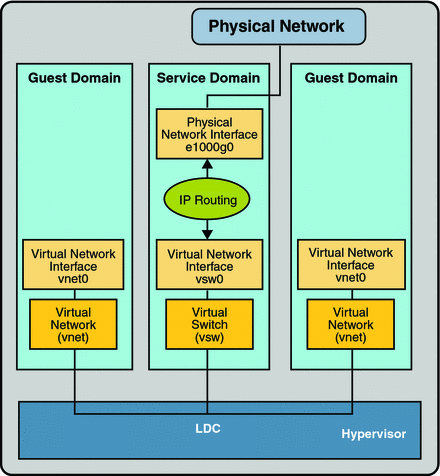Configuring Virtual Switch and Service Domain for NAT and Routing
The virtual switch (vsw) is a layer-2 switch, that also can be used as a network device in the service domain. The virtual switch can be configured to act only as a switch between the virtual network (vnet) devices in the various logical domains but with no connectivity to a network outside the box through a physical device. In this mode, plumbing the vsw as a network device and enabling IP routing in the service domain enables virtual networks to communicate outside the box using the service domain as a router. This mode of operation is very essential to provide external connectivity to the domains when the physical network adapter is not GLDv3-compliant.
The advantages of this configuration are:
-
The virtual switch does not need to use a physical device directly and can provide external connectivity even when the underlying device is not GLDv3-compliant.
-
The configuration can take advantage of the IP routing and filtering capabilities of the Solaris OS.
Figure 7–2 Virtual Network Routing

 Set Up the Virtual Switch to Provide External Connectivity to Domains
Set Up the Virtual Switch to Provide External Connectivity to Domains
-
Create a virtual switch with no associated physical device.
If assigning an address, ensure that the virtual switch has an unique MAC address.
primary# ldm add-vsw [mac-addr=xx:xx:xx:xx:xx:xx] primary-vsw0 primary
-
Plumb the virtual switch as a network device in addition to the physical network device being used by the domain.
See Configure the Virtual Switch as the Primary Interface for more information about plumbing the virtual switch.
-
Configure the virtual switch device for DHCP, if needed.
See Configure the Virtual Switch as the Primary Interface for more information about configuring the virtual switch device for DHCP.
-
Create the /etc/dhcp.vsw file, if needed.
-
Configure IP routing in the service domain, and set up required routing tables in all the domains.
For information about how to do this, refer to Packet Forwarding and Routing on IPv4 Networks in System Administration Guide: IP Services.
- © 2010, Oracle Corporation and/or its affiliates
